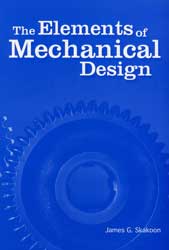
Posted to News on 26th Jun 2008, 20:11
The Elements of Mechanical Design - a book review
ASME Press has published a new book by James G Skakoon entitled The Elements of Mechanical Design. Concise and readable to suit the needs of busy engineers, it will prove useful to students and practitioners alike. What it contains is a distillation of years of designers' experiences, rather than the theory and science that is found in most engineering text books.

Roughly A5 size (it is, after all, published in the USA), the book runs to 104 pages and is full of advice and guidance, illustrated with practical examples.
The body of the book is divided into three parts covering Elementary rules of mechanical design, Essentials of thought and procedure in mechanical design, and Some practical advice. In addition, there are appendices for Rules for exact constraint, Nesting force windows in exact constraint design, Design for assembly rules, and a section headed With experience comes wisdom (a series of quotes from mechanical design engineers).
Part I - Elementary rules of mechanical design
This section addresses the types of issues that might be mentioned in passing during lectures but that really deserve further explanation - which is what the book provides. For example, it considers simplicity and complexity of designs, separation of functions, constraints, load paths, triangulation and self-help (for the design, not the designer). There is also useful advice about bending, tension, compression and friction.
Part II - Essentials of thought and procedure in mechanical design
This short but useful part of the book is where the subject of problem solving is tackled. Procedures suggested include working in 3D rather than 2D, rearranging the geometry to find a better solution to the problem, building prototypes at the appropriate points in the design process, and separating strength and stiffness. The author also offers advice on avoiding problems caused by buckling, and recommends ways to minimise design risk.
Part III - Some practical advice
It has to be said that by the time the reader reaches this part of the book, the author has already imparted some practical advice - such as "separate strength from stiffness" and "never overlook buckling phenomena." Nevertheless, Part III still contains plenty of helpful hints and tips. These obviously cannot cover every aspect of mechanical design, but they are diverse, ranging from press fits, torsional rigidity and spring design, through to tolerance paths, mechanical amplification and the design of assemblies.
Conclusion
Students and design engineers with little experience will find this book offers a short cut to climbing the learning curve. It is also likely that experienced design engineers will find something of interest or, if not, will be reassured that they are doing the right things! Either way, the book is reasonably priced and highly recommended.
Copies of The Elements of Mechanical Design (ISBN 978-0-7918-0267-0) can be ordered directly from ASME in the USA (price $28) or through Eurospan (Price 23.95). It is also available via high street and online booksellers.
Want the latest machine building news straight to your inbox? Become a MachineBuilding member for free today >>

















